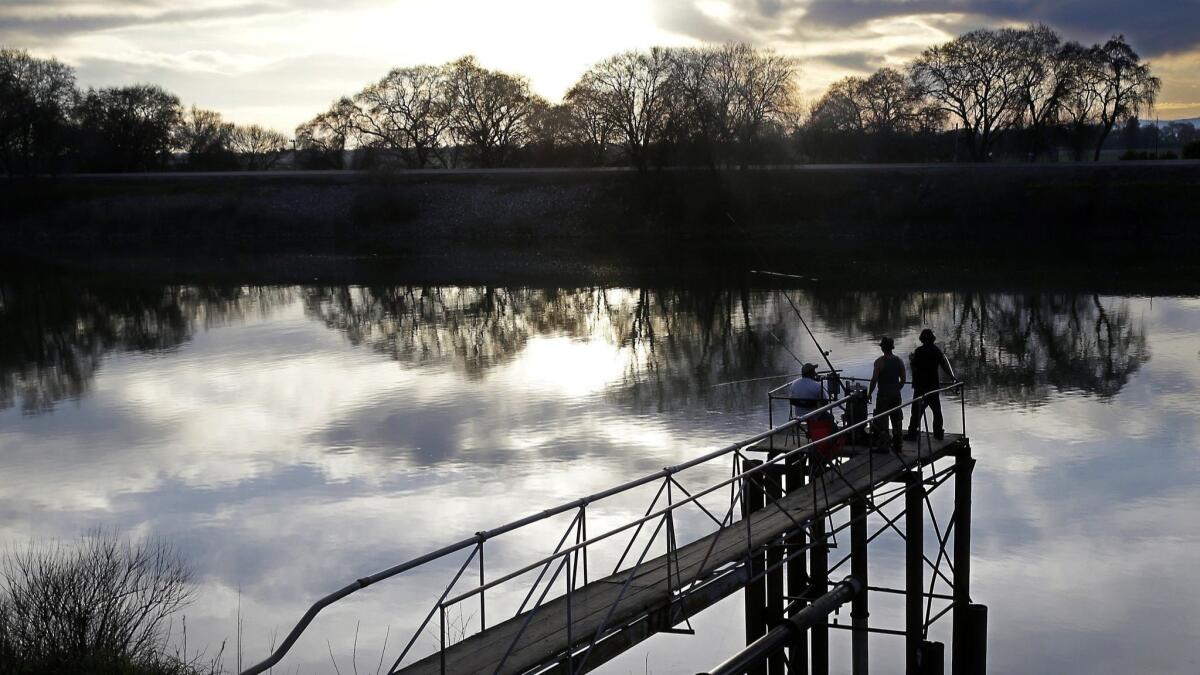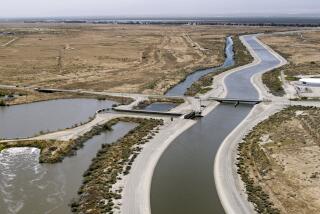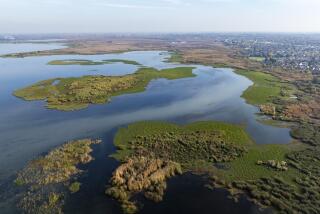Capitol Journal: What do Southern Californians really get out of Gov. Jerry Brown’s twin tunnels project?

The most expensive state public works project ever would be financed primarily by Southern California water users. But it’s not exactly clear what they’d be buying.
Gov. Jerry Brown’s $17-billion twin-tunnels project in the Sacramento-San Joaquin Delta would either:
- Deliver more water to Southern California than it gets today;
- Deliver less;
- Deliver the same.
There are wide-ranging views about how California’s largest water hole should be divvied up. More for Southern California homes and industry? More for thirsty San Joaquin Valley farms? More for tanking delta salmon and other endangered species?
Nothing new there, but it’s all colliding as key government entities head in seemingly conflicting directions.
The answer is important for Southland water ratepayers because their monthly bills would rise to bankroll most of the ambitious project. What benefit would they receive in return?
The Metropolitan Water District of Southern California, which services 19 million customers, estimates average monthly bills would increase by $4.80. But who really knows? That assumes tunnel construction wouldn’t balloon into significant cost overruns like virtually every other big government project.
This is the project in a clamshell: Two 35-mile, 40-foot-wide tunnels under the delta from the estuary’s northern end on the Sacramento River to aqueducts at the southern edge. The water would flow into the San Joaquin Valley and be pumped over the Tehachapi Mountains to Southern California.
For half a century, the water has been fed into the aqueducts by giant southern delta pumps that have reversed San Joaquin River flows, confusing migrating baby salmon. The pumps chomp up all manner of fish, including salmon and endangered tiny native smelt. Courts have tightened the pump valves to protect the critters, angering valley farmers.
The tunnel operation would be more fish-friendly with modern screening. And water siphoned off the Sacramento River in the northern delta would be fresher than what’s pumped now from the more brackish southern region.
But freshwater flows into the delta would be rerouted into the tunnels. Little delta communities, small farmers and environmentalists are fighting the project. They envision saltwater intrusion from the San Francisco Bay. They point out that freshwater fish — even salmon tykes — need fresh water. They’re crying “water grab.”
Southern California gets 30% of its water from the delta.
The tunnels would carry 9,000 cubic feet of water per second. But roughly half of the delta’s exported water still would be fed into the aqueducts by the southern pumps, killing fish.
In recent days, the question of the project’s benefits to ratepayers has been raised indirectly in reports issued by the Metropolitan Water District and the powerful state Water Resources Control Board.
The MWD offered a rosy projection of increased delta water imports to board members voting Tuesday to reaffirm a 65%, $11-billion investment in the project.
It envisioned roughly 1 million acre-feet more delta water being exported annually through the State Water Project if the tunnels are built. About half would go to MWD, the rest to places like Kern and Santa Clara counties.
Coverage of California politics »
Meanwhile, the state water board — which must issue permits before tunnel construction can begin — unveiled a preliminary plan last week to increase freshwater flows through the delta by 2 million acre-feet annually. The goal is to help declining fish.
“You can’t increase the outflow [into the bay] by 2 million acre-feet and increase delta [export] pumping by 1 million acre-feet,” says Barry Nelson, an environmental consultant and longtime veteran of California water wars. “It’s a big conflict.”
It’s a policy that should be resolved before billions more dollars are invested in delta water.
Brown’s water resources department, the project’s chief overseer and promoter, has been treading a slippery log on this issue for years. It doesn’t want northerners to fear losing more water to southerners. But it wants southerners to believe the tunnels would pay off.
“It’s not about taking more water from the delta, it’s about avoiding further declines,” department spokeswoman Erin Mellon says. “If we continue along the path of the status quo, we’ll lose 20% of the delivery. We’d lose 1 million acre-feet per year due to increased pumping restrictions.”
Felicia Marcus, Brown’s appointed water board chairwoman, asserted in an op-ed piece for the Sacramento Bee on Tuesday that “native fish, such as chinook salmon and steelhead, are on the brink of extinction…. Yes, leaving more water to flow into the delta from both the San Joaquin and Sacramento watersheds will be challenging for water users….
“Water users can adapt — by switching crops, becoming more efficient and storing more water in wet times. In contrast, species pushed to the brink of extinction have few options.”
Those are fighting words in the San Joaquin Valley.
Brown and the MWD are racing to get all the pre-tunneling done they can before the next governor takes over in January. It’s a cinch to be Lt. Gov. Gavin Newsom, who’s not wild about the project. He’d like to compromise on a single tunnel.
“The status quo is unacceptable,” Newsom says. An updated water export system “that protects and advances the health of the delta has to be a priority of the next governor.”
But he adds: “I strongly believe California must work to reduce our dependence on the delta by focusing on regional solutions … recycling and groundwater replacement and conservation.”
To be continued by the next governor.
Follow @LATimesSkelton on Twitter
More to Read
Get the L.A. Times Politics newsletter
Deeply reported insights into legislation, politics and policy from Sacramento, Washington and beyond. In your inbox three times per week.
You may occasionally receive promotional content from the Los Angeles Times.







